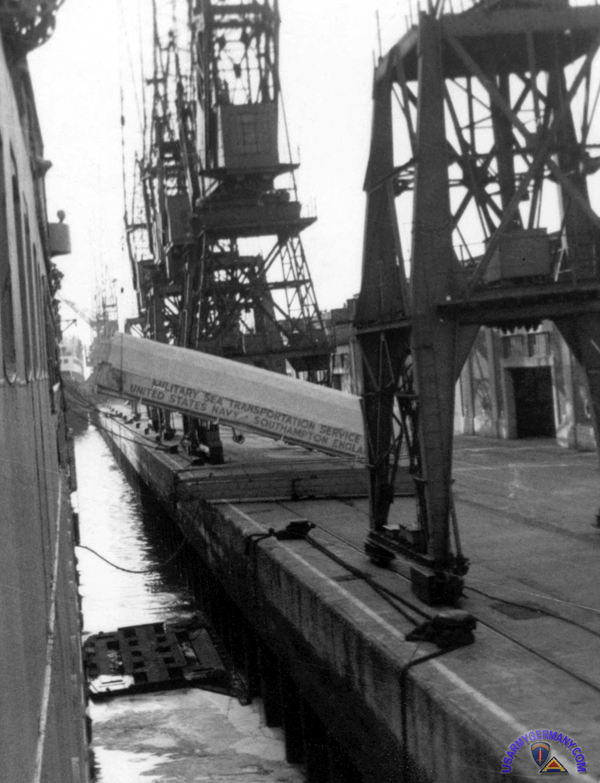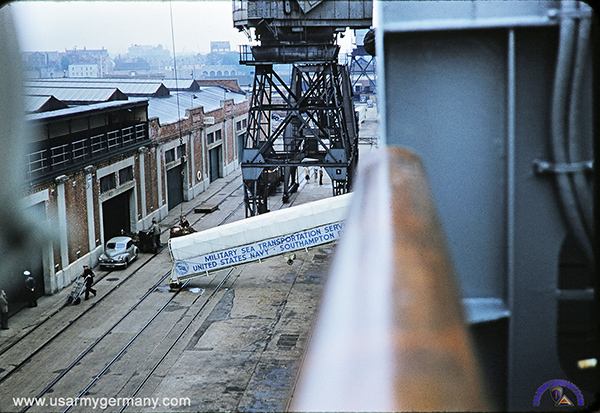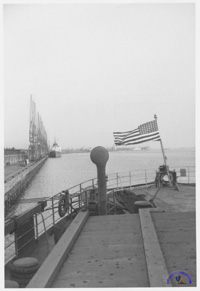| If you do
NOT see the Table of Contents frame to the left of this page, then
Click here to open 'USArmyGermany' frameset |
|||
|
Sub-ports in the United Kingdom |
|||
|
|
|||
|
|||
|
|
|||
| United Kingdom Sub-Port (Burtonwood) | |||
| 1956 | |||
| (Source: STATION LIST, 15 August 1956) | |||
| United Kingdom Sub-Port, Bremerhaven Port of Embarkation at Burtonwood |
|||
| 1965 | |||
| (Source: STARS & STRIPES, Jan 6, 1965) | |||
| US Army Transportation Terminal Unit, United Kingdom The UK Terminal Unit at London manages military supplies to and from Britain. Annually about 350,000 tons of military goods (worth about $2 million) pass through the ports under the terminal's command. They are shipped by sea to and from the US as part of the program of maintaining US installations in Britain. CO of the UK Terminal Unit is Lt Col Wayne Allred. Army personnel assigned to the UK Terminal Unit supervise the loading and unloading of some 60 vessels a month. About 6,000 vehicles and 5,000 passengers a year pass through the ports. (Webmaster note: these numbers appear to be on the low side.) Southampton is the passenger port. It is also the main port for EES items from the States which are then trucked to warehouses at West Ruislip. Liverpool is the main port for subsistence. The subsistance depot is located at RAF Burtonwood. Felixstowe, on the east coast, is used for cross-channel cargo, including Rhine steamers that ply to and from Mannheim, Germany (the Rhine River Terminal). Explosives are moved through Milford Haven, Wales. This operation is supervised by personnel from Southampton. The Port of London handles primarily US military household goods, mail, and shipments originating from other foreign destinations. |
|||
| Southampton Sub-Port | |||
 Troop ship docked at Southampton sub-port, 1950s |
|||
| 1956 | |||
| (Source: STARS & STRIPES, July 30, 1956) | |||
|
|||
| The MSTS representative at Southampton is Navy Lt William T. Benson. He is assigned to MSTSELM. Detachment 2 has two major branches (administrative branch and operations branch) under which are five sections (passenger movement, automobile, cargo, documentation and budget & fiscal). As the port authority, Det 2 operates closely with the personnel movement section of 3rd Air Force HQ (South Ruislip) and the 7551st Personnel Processing Sq (Shaftesbury), as well as the US Embassy and Navy HQ in London. OPERATIONS Soon after the time of an embarkation or debarkation is announced by the port commander, Det 2's various sections swing into action. During an embarkation, the passenger movement section provides personnel at the bus or rail unloading point to direct passengers to the processing area, gives a brief orientation on the processing procedure, assists passengers in their immigration clearance and the clearance of cabin baggage through customs, and finally directs passengers to the gangway for boarding ship. The cargo section directs stevedoring activities, sorting cargo or any of the myriad tasks required in loading and unloading the vessels. It coordinates the movement of cabin baggage from Shaftesbury to the loading berth with the passenger movement section, the 7551st Processing Sq and the dock superintendent, and supervises the unloading of baggage trucks and the placing of baggage on the pier. Passenger lists are prepared and reproduced by the documentation section based on information contained in the berthing list and troop orders furnished by 3rd Air Force and 7551st Processing Sq. During a debarkation, Det 2 personnel go aboard ship to process passengers for debarkation. After troop passengers debark, unaccompanied dependents are processed, followed by concurrent-travel military personnel and their dependents. In the ship's lounge, a passenger movement section representative gives a briefing on debarking procedures. After passing the immigration table, passengers move on to the finance table where an Air Force representative from Shaftesbury handles the money conversion. Det 2 personnel assist passengers in the clearance of their baggage through customs and direct them to the bus area. At Shaftesbury, 45 miles from Southampton, the 7551st handles the processing and orientation of military personnel and dependents prior to reporting to their newly assigned units in Britain. In the case of unaccompanied dependents, UK-based personnel are notified well in advance of their dependents' date of arrival in order to meet them at the port. TROOP SHIPS & COMMERCIAL LINERS Among the regular-scheduled MSTS vessels coming into Southampton are the following These ships are staffed by a civilain skipper and crew, with a military department aboard. Two Navy transport ships that make a regular stop at Southampton are the USS General Henry W. Butner (T-AP-113) and USS General George M. Randall (T-AP-115) - both are commissioned ships with a Navy skipper and crew. In addition, the liners United States and America also come to Southampton. These commercial ships carry a limited number of military personnel and dependents -- about 50 a month during the tourist season and about 200 a month during the off-season. Det 2 handles about 10 passenger and 4 cargo ships a month. Automobile section: In the past 11 months, this section has processed over 3,000 vehciles inbound and nearly 2,000 outbound. The automobile section receives a manifest of cars about a week before the scheduled date of arrival. As soon as the manifest is received, all base transportation officers are sent a list of the owners and the pickup dates. |
|||
| Operation FRELOC | |||
| 1967 | |||
 Seaports involved in the relocation of US military supplies from France to the UK in 1967 (TRANSPORTATION PROCEEDINGS map slightly modified by webmaster) |
|||
 |
|||
| Related
Links: |
|||



